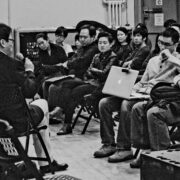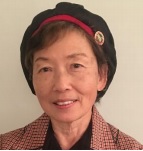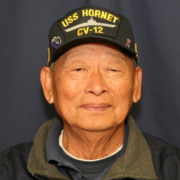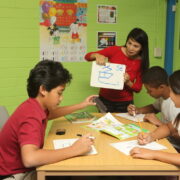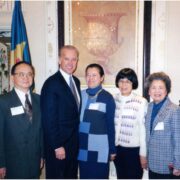The First Action:
The Birth of the Taiwan Center Building Committee
Author: Patrick Huang
The Taiwan Center is located on North Boulevard, Flushing, New York City. This place was developed very early. Quaker Meeting House, one of the most famous places, dates back more than three hundred years. Although it is within walking distance from busy Main Street, what you see are towering old trees and antique buildings, exuding the tranquility of the history and the elegance of the ancestors. Wandering around makes you forget all your troubles and feel refreshed. It is a blessing that the Taiwan Center is standing among these historical buildings.
Taiwan Center celebrated its inauguration on July 19, 1986. However, its official preparations can be traced back to November 12, 1983, when the Building Committee was formed. The period lasted for two years and eight months. This story of the birth of the Taiwan Center Building Committee reflects how self-reliant and united the overseas Taiwanese were.
I left the University of Minnesota in 1979 and came to New York alone. With no family and plenty of time, I participated in many activities. My most profound feeling at the beginning was that there were a large number of Taiwanese in New York City, many of them were very talented, and their groups were very diverse with a wide range of names. Nevertheless, their activities were the same as those of people in small cities in Taiwan, they didn’t have their own meeting place. Rather, they held activities at temporary stands in conjunction with other organizations’ events. Perhaps because I studied sociology, I was unconsciously concerned about the limitations of this type of temporary and unsecured meeting places.
I thought that with so many Taiwanese there, it was time to integrate small group activities into a “Taiwanese community” to further advance the vitality of Taiwanese.
Without a physical and visible community center at a permanent location, Taiwanese community activities would be more chaotic and less effective than they could be. The effort would end up being noble but unproductive.
Fortunately, when I participated in the “Taiwan Day” event hosted by the Taiwanese American Association of New York, President Martin Tsai earnestly said in his speech that we should have our own meeting place and he would work hard to reach this goal.
This is the first time that I heard of the name “Taiwan Center.” Gradually I met more people like Lung-Fong Chen, Liang-Chi Peng, Fu-Hsiung Chang, Rui-Ming Wei, A-Huo Chen, and Cheng-Bin Ku. In Listening to their conversations I could strongly feel the infinite ambitiousness towards the idea of a “Taiwan Building” or “Taiwan Hall.” Despite of our distinctive different backgrounds, origins and professions, it was obvious that many of us were weaving a shared dream of overseas Taiwanese.
At this time, Dr. Maurice Hsu was advocating the establishment of a “Taiwanese Community Council” to strengthen links and mutual assistance among multiple associations. The member associations of the founding members included the Taiwanese American Association of New York, the Taiwanese American Association of New Jersey, Dr. Chen Wen-Chen Memorial Foundation, the Taiwanese Association for Human Rights New York Chapter, the Formosan Association for Public Affairs (FAPA) New York Chapter, and NY Taiwan Society. Everyone publicly nominated Dr. Hsu as the founding president.
The establishment of the Taiwanese American Council is a watershed in the birth of a Taiwan Center. In terms of strength, although the Taiwanese American Council at that time was more symbolic than realistic, in many of the Taiwanese American Council meetings that I participated representing the NY Taiwan Society, the discussion about Taiwan Center was a frequent topic.
In 1983, I took over from Dr. Hsu and became the second president of the council. I was like a newborn cub, not afraid of anything. I believed that it was time for the establishment of Taiwan Center and thus began to take action: I invited Mrs. Yi-Yi Chang, who was in the real estate business, to make plans for the purchase details of a Taiwan Center. I left the problem of fundraising to myself.
Everything is difficult, especially in fundraising. My strategy at the time was to start with it despite of anything. I thought that as long as we made the train leave the station, the passengers would just jump up automatically. Therefore, in September 1983, “People’s Fundraising Regulations” was announced, calling on the members of the Taiwanese American Council to follow the example of Taiwanese temple festivals to collect Building Fund for Taiwan Center” by head count in every activity. The aim was to make the fundraising a long-term and grassroots one. Two months after the announcement of the regulations, the money had not been raised, but the more important “visibility” was obtained, which was very good publicity and led to the success of the next step: a “Dinner party for establishing a Taiwan Center Building Committee.”
On November 12, 1983, the dinner party, organized by Mr. Jong-Guan Lin, was held at the East Garden Restaurant in Midtown, Manhattan. Each participant paid ten dollars and the insufficient fund was all paid up by Lin. As the president of the council, I invited all the people to join the event. Taiwanese people should be very proud of themselves since although it was clear enough that it was a fundraising event, they still crowded the second floor of the restaurant. The highly respected Rev. Wu-Dong Huang and the President of the World Federation of Taiwanese Associations, Dr. Tu Chen, were invited to help out, too.
Under the active encouragement of President Chen, who came all the way from San Francisco, and the challenge from Rev. Huang, the atmosphere of “If not me, who else” was pervasive among the audience. We first elected 42 members, including Dr. Hong-Tien Lai, for the “Taiwan Center Building Committee”, and then set up an “Executive Committee” under the Building Committee, elected 21 members including Lung-Fong Chen. The nominees and elected candidates throughout the election process were all very straightforward. No one dared to say that they needed to go home to first ask their wives’ or husbands’ permission.
At the party, Mrs. Yi-Yi Chang also had a surprising proposal for the purchase of Taiwan Center. She suggested two options: Option A consisted of an auditorium, which required 500,000 to one million dollars to purchase a large building such as school, church, warehouse, etc. Option B was without auditorium thus only would cost 150,000 to 200,000 dollars to purchase a smaller building, such as a three-story house. In this house, it would have a Friendship Hall on the first floor, classrooms and offices on the second floor, and the third floor would be for short-term dormitories. As for the financial resources, Mrs. Chang proposed three principles: (1) Each elected member of the Building Committee would be responsible for a set amount of funding (3,000 to 5,000 dollars) as the down payment to buy a three story house, (2) Every month, ten members would be sought out to share the mortgage loan for the month. (3) The above fundraising was going to be carried out by means of investment. All funders would be shareholders and have the property rights of the center.
That night, everyone acted and talked with great momentum. After listening to Mrs. Chang’s report, we made a big wish and suggested that a three-story house was not enough. We were talking about how dignified Japanese Society and Chinese Consolidated Benevolent Association were, and that Taiwan Center should represent the identity of Taiwanese at least as well…, In short, we hadn’t started to raise money but had been proactively and enthusiastically discussing and criticizing all those details. Looking back at that moment, I strongly feel the daring, vitality and loveliness of Taiwanese people.
With the limited time we had that day, the following principles were finalized: (1) The funders would own the property rights, and the building would be provided free of charge to the Taiwan Center; (2) We will continue to solicit enthusiasts and expand the Building committee; (3) Responsibility for all details and actions plans would be transferred to the Executive Committee. The dinner party for the Taiwan Center Building Committee ended successfully in a mixed feeling where everyone was excited but felt a great responsibility at the same time.
On November 23, 1983, the Executive Committee held the first meeting in the office of Dr. Hong-Tien Lai and elected the cadres and task groups. The meeting was chaired by Cheng-Bin Ku. We elected Lung-Fong Chen as the Chairman, Martin Tsai and Cheng-Bin Ku as the Deputy Chairmen and invited Rev. Wu-Dong Huang as our consultant. The task preparation was divided into six groups with each group having a person in charge: Fang J. S. Fang for the financial group, Morisan Lu for the publicity group, A-Huo Chen for the planning group, Martin Tsai for the fundraising group, Cheng-Bin Ku for the engineering group, and Patrick Huang for the secretary group. We also set a plan to raise 500,000 dollars within six months. From that moment on, the train to build a Taiwan Center was officially launched under the direction of the new conductor Lung-Fong Chen.
Today (1996), the train has been running for thirteen years: the Center was completed and has been in use for ten years. In the meantime, the number of passengers (donors) who bought tickets for getting on the train exceeded 400. I am always grateful to those members who were fighting in the front and the executives who were responsible for raising funds, purchasing, constructing, decorating, and turning our dreams into reality. After going through ten years of wind and rain, many people still passionate and cherish the Taiwan Center. But there are also many people not satisfied with either the past or the present conditions of the Center. I hope that in the next ten years, Taiwan Center will continue to grow. More people will buy tickets to get on this train and continue to reflect the spirit of “where there’s a will, there’s a way”. Let’s look forward, carry on and write a more brilliant new chapter together!
Excerpt from the 10th Anniversary Special Issue of New York Taiwan Center July, 1996

